Understanding the development of scenes is crucial for creating a captivating and well-structured story. A well-written scene can keep readers engaged, advance your plot, and provide significant character development.
Susanne Lakin’s scene structure is an excellent tool for creating adaptable and efficient scenes that will hold your reader’s attention and keep your story moving. And with Plottr, the Susanne Lakin scene template will help you leverage this structure in your story planning. Learn how.
What is the Susanne Lakin Scene Structure?
C.S. Lakin is known for her diverse published works, including novels, non-fiction books, and her ‘Live Write Thrive’ blog. She has authored multiple novels in various genres, such as mystery, romance, and fantasy, as well as instructional books on writing and storytelling, including The 12 Key Pillars of Novel Construction and Layer Your Novel.
Plottr’s Susanne Lakin Scene Template is based on her work, and breaks scenes into 11 critical elements. These ensure that every scene serves a focused purpose that advances the plot and develops characters.
Using this structure, you can create scenes rich in detail and emotion, making your stories more immersive and captivating.
Three Ways the Susanne Lakin Scene Template Sharpens Your Scenes
Planning your story scene-by-scene is an effective way to take bite-sized steps toward the finish line of your novel, and ensure that your writing serves a purpose and keeps readers hooked right from the start. Depending on your style, the Susanne Lakin Scene Template can help you with:
Structured Scene Building
Authors who prefer outlining and planning their stories can use a template like this one to ensure each scene is rich in detail, streamlining the writing process and creating a more cohesive story. Follow the 11 provided elements as the groundwork for detailed notes that will help provide guardrails so the actual writing can progress with greater ease.
Guidance for Pantsers
While the template provides structure, it doesn’t stifle creativity. Using a clear reference for each scene can guide character and plot exploration, ensuring purposeful scenes.
Use the structure to help ground you in your story development, but don’t feel the need to illustrate every detail if you’d rather let those flow more freely as you compose the scene itself.
Effective Scene Revisions
If you’re in the revision stage, the Susanne Lakin Scene template can help identify sections of your writing that need reworking to ensure they contribute to the story’s progression.
Explore the Susanne Lakin Scene Template in Plottr
This scene template is an incredibly useful tool that can make a big difference in organizing and crafting scenes. It provides a clear structure and guidelines to help you create engaging, effective, and well-structured beats.
Once you apply the template to a scene card, you’ll see all 11 of these key components:
- Locale: Craft a vivid, immersive backdrop for your characters and events by defining the scene’s setting, enabling your readers to enter the story’s world.
- Time of Day: Set the mood and atmosphere by specifying your scene’s precise time of day, from the ethereal glow of dawn to the mysterious depths of midnight.
- Time of Year: Infuse thematic depth into your narrative by indicating the season or time of year in which your scene unfolds, influencing the emotions and experiences of your characters.
- Weather: Describe the weather conditions that impact the characters’ actions, emotions, and the overall tone of the narrative.
- Time Passed Since the Previous Scene: Maintain a consistent timeline by specifying the elapsed time since the last scene with the same character, ensuring a seamless flow of events.
- POV Character for the Scene: Allow readers to experience the story through a character’s unique lens by selecting the character’s point of view for the scene, fostering empathy and connection.
- Advancing the Story and New Plot Points: Highlight significant plot developments, revelations, and turning points to keep readers engaged and maintain plot coherence.
- Conflicts and Obstacles: Drive the narrative forward by identifying your characters’ conflicts and obstacles, intensifying the stakes, and keeping your audience seated.
- Character Growth: Showcase the evolution and development of your characters by illustrating how they change or grow by the end of the scene and how that change contributes to their overall arc.
- High Moment or Key Info: Share the pivotal moments and crucial information within the scene, providing essential context and intrigue.
- Backstory and World-building: Enrich your story’s depth by revealing the right backstory elements and world-building details at the right time to immerse your readers in a fully realized narrative universe.
It’s a lot of information; articulating these details thoughtfully in your narrative (showing and implying some while telling others) will make it feel more real and impactful.
Scene Analysis Using the Susanne Lakin Scene Template
Now that we’ve gone over the basics of this scene-building theory, let’s walk through an example so you can see it in practice.
Putting the opening scene of Where the Crawdads Sing into the template gives a prime example of how C.S. Lakin’s scene structure can effectively establish the setting, characters, conflicts, and key plot elements:
Locale: The story opens in the remote and wild coastal marshes of North Carolina, which are vividly described and become a central locale throughout the story.
Time of Day: The scene occurs at dawn, just before sunrise. This time of day symbolizes a new beginning and adds an element of mystery and beauty to the setting.
Time of Year: The story begins in the late 1940s, and the opening scene reflects the spring season. The marsh comes alive with the sounds of birds and other wildlife during this time of year.
Weather: The weather in this scene is described as calm and serene, setting a peaceful tone for the story’s start.
Time Passed Since the Previous Scene: The novel begins with Kya as a young child and then swiftly moves to her mother’s abandonment of her, marking a significant event that shapes her life. The time passed here is a few years between Kya’s childhood and the present.
POV Character for the Scene: The scene is primarily narrated from the perspective of an omniscient third-person narrator, providing readers with an overview of Kya’s situation and her mother’s actions.
Advancing the Story and New Plot Points: This scene sets the stage for the story, introducing readers to Kya, the “Marsh Girl,” and her mother’s abandonment of her. It hints at the central conflict of Kya’s isolation and abandonment and the mysteries surrounding her mother’s actions.
Conflicts and Obstacles: The primary conflict in this scene is Kya’s abandonment by her mother, which leaves her to fend for herself in the harsh environment of the marsh. This abandonment is an obstacle that Kya must overcome as she grows up.
Character Growth: While this scene focuses on Kya as a young child, it lays the foundation for her growth and development throughout the novel as she learns to survive and adapt to her solitary life.
High Moment or Key Info: The critical information revealed in this scene is Kya’s mother’s departure, which shapes Kya’s future and her need for self-sufficiency. It’s a pivotal moment in the story’s setup.
Backstory and World-building: The scene provides essential backstory by showing Kya’s mother leaving, introducing readers to the marsh, and alluding to the local community’s fear and misunderstanding of Kya. This world-building sets the stage for the novel’s themes.
How to Use the Susanne Lakin Scene Template in Plottr
Incorporating the Susanne Lakin Scene Template in Plottr is a straightforward process. Once you have Plottr setup on your computer, just follow these five steps to add the Susanne Lakin scene template to your scene card:
- Step 1: Open Plottr and click Create Blank Project to start a new project (or open an existing one)
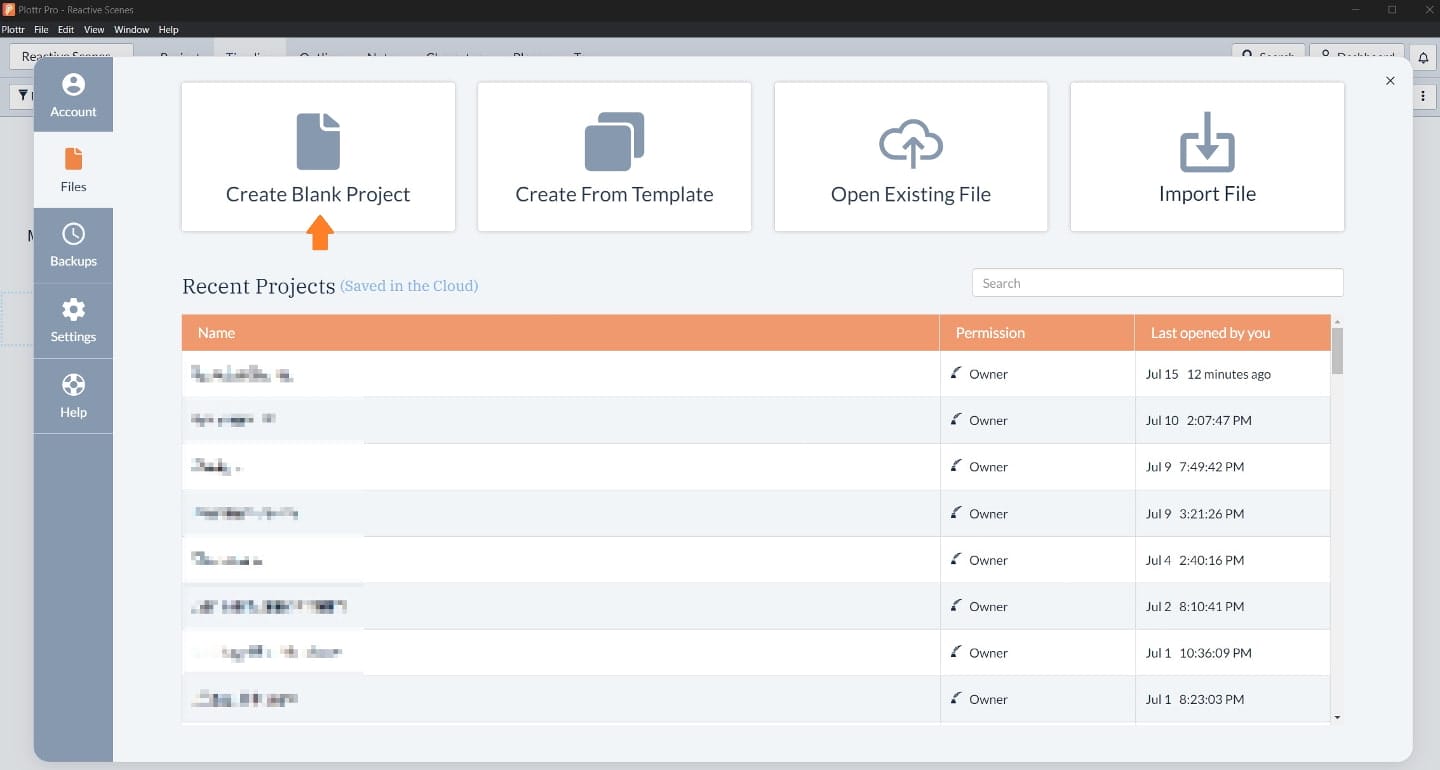
- Step 2: Hover over the plotline where you want to add a scene card and click Use Template in the box that appears
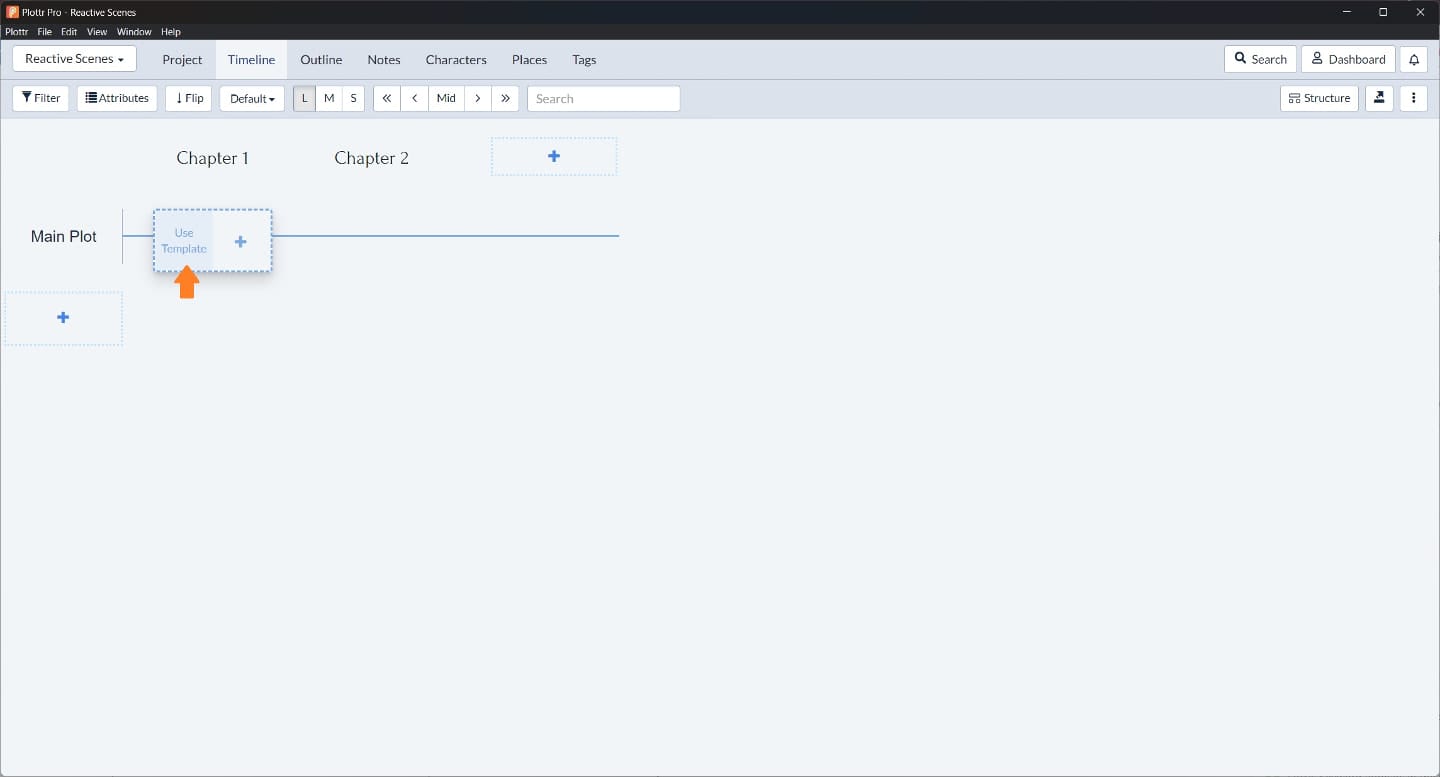
- Step 3: Select Susanne Lakin Scene from the list of scene templates and click Choose to add it to your scene card

- Step 4: Name the scene card and press Enter to save it
- Step 5: Open the card and start filling out the template!
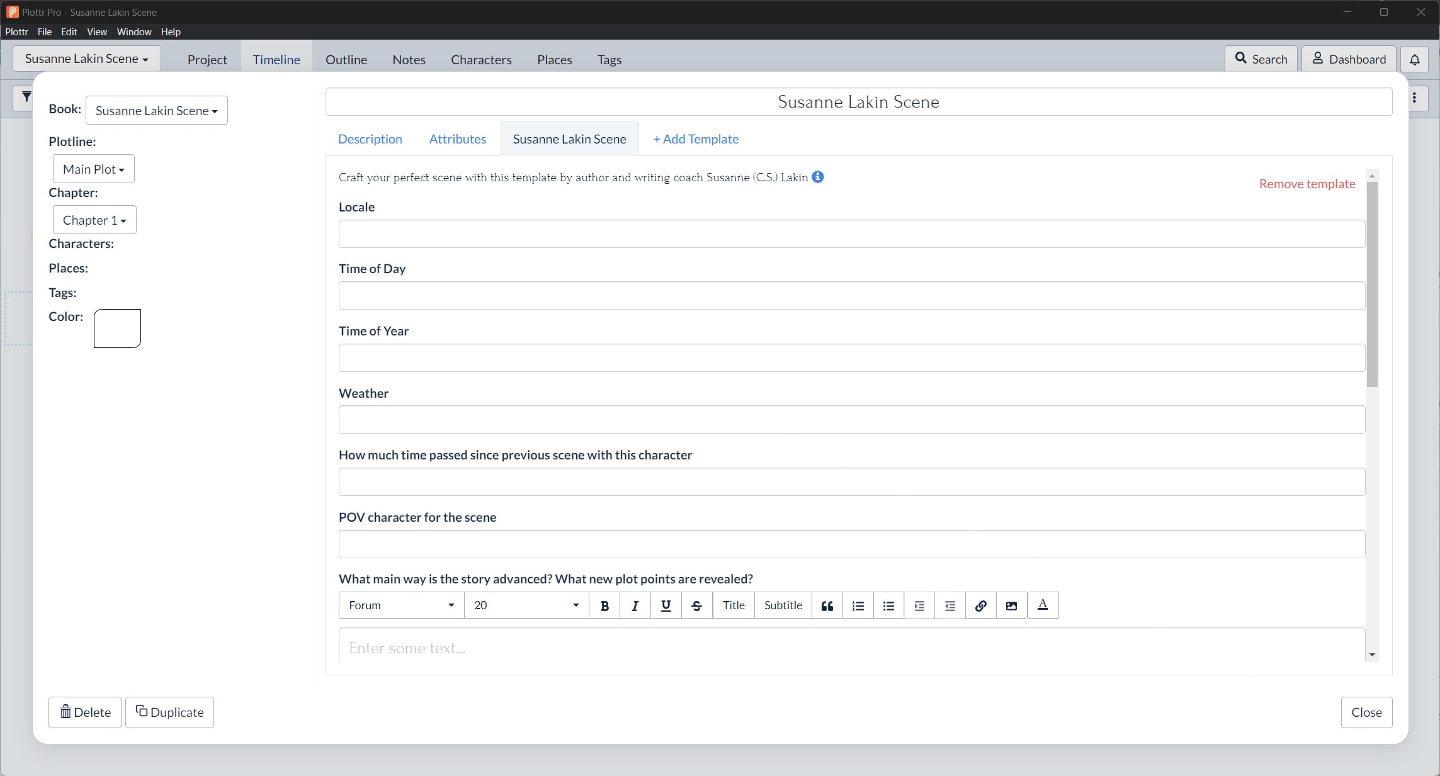
You can also add a template to an existing scene card by clicking the +Add Template button within the scene card, much like you would on a character profile.
Try these other scene templates in Plottr:
Scening is Believing
Whether you’re a plotter or a pantser, this scene template will streamline your writing process, add depth to your characters and settings, and ensure that every scene contributes meaningfully to your story’s progression.
Ready to unleash your story’s full potential? , Sign up for a free trial or purchase Plottr today and see how this template, along with many other features, can help you create more complex and compelling scenes.

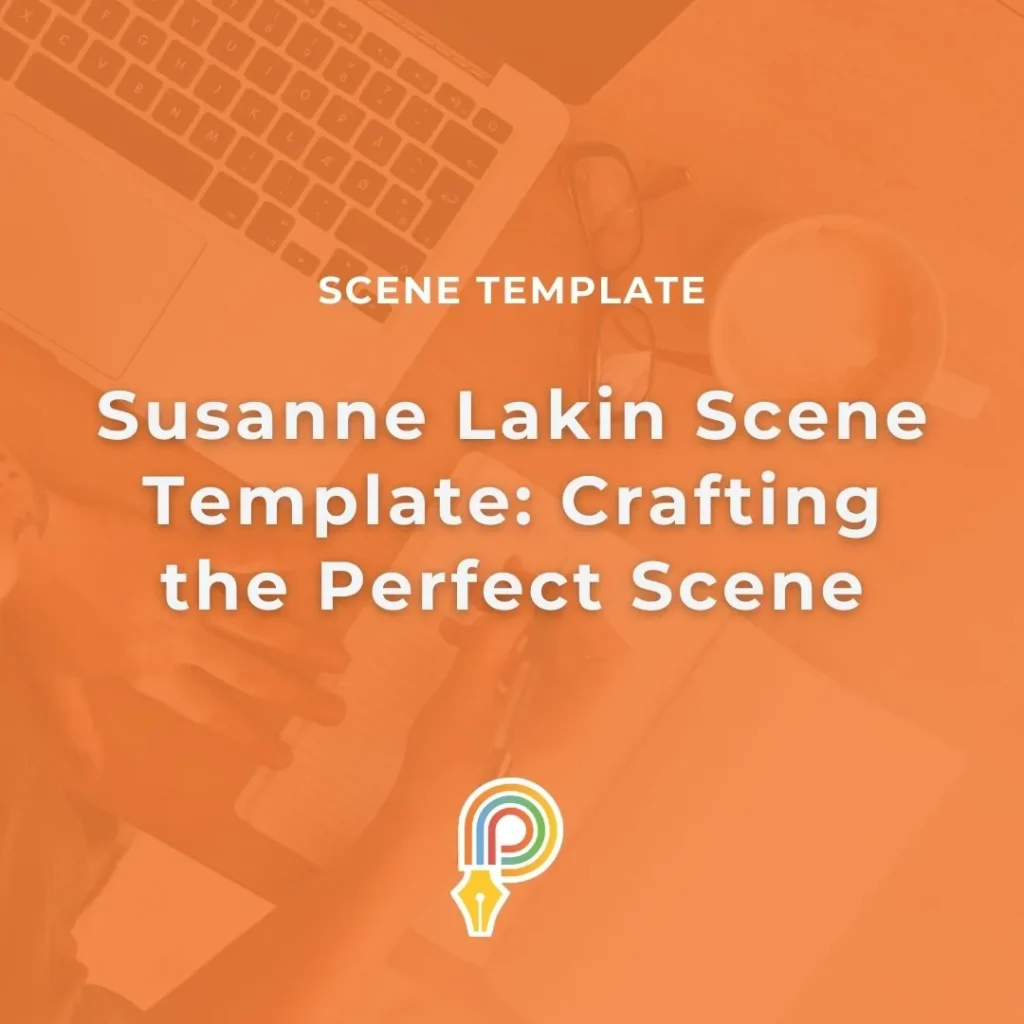


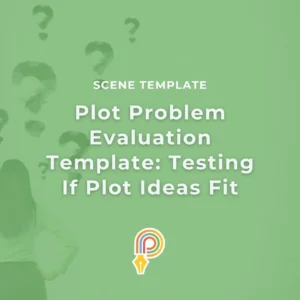
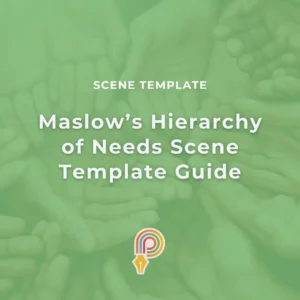

Comments